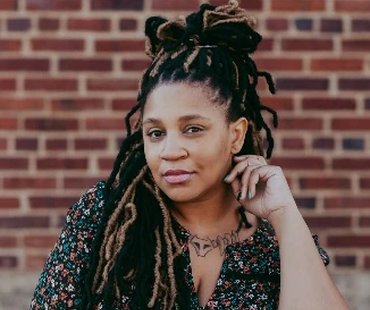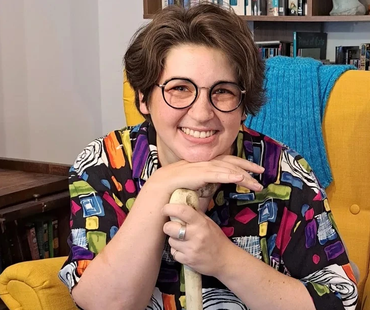“Anyone can wear the mask”: how the Spider-Verse's first wheelchair-using hero was created
From fan art to the movie, Dayn Broder tells us how inventing Sun-Spider was a way to become a hero, mobility equipment included
Spider-Man has a secret superpower. Not one as obvious as his wall-crawling, web-slinging or head-jangling Spidey sense. But it’s been there, mingling in the character's DNA with that radioactive spider venom since he made his comic book debut 61 years ago in Amazing Fantasy #15 – inclusivity. Spider-Man has always been the most inclusive superhero.
He swung into a world of costumed heroes the same age as the average reader’s parents. There were alien orphans with god-like powers (Superman), traumatised playboys with a billion-dollar budget for bat-themed gadgets (Batman) or Amazonian goddesses with magic lassos and invisible planes on-call (Wonder Woman). They were undoubtedly heroic. But they were not relatable.


Why anyone could be Spider-Man
Spider-Man was different. He could be any self-conscious teenager, give or take a transforming spider bite. Marvel supremo Stan Lee remarked that co-creator artist Steve Ditko’s iconic full-coverage Spidey costume meant that every reader of any race or background could imagine they were behind the mask. Alter ego Peter Parker’s adolescent issues with school, bullies, and girlfriends were instantly recognisable to thousands of comic book fans. They identified with him and loved him for being more like them. The character was an instant sensation, grabbing attention on the newsstands and later on TV and film.
Over the years, different audiences slowly saw themselves reflected in the stories, even if comics and society were starting from a primarily white male place. The first Spider-Woman was introduced in 1977, and in the last decade or so, Marvel has spun a wider web of representation. If you’re younger, your Spider-Man isn’t Peter Parker; he’s Miles Morales (below), a biracial teenager who debuted in 2011 and is the lead in the acclaimed Spider-Man: Spider-Verse trilogy of animated movies.


Introducing the Amazing Sun-Spider
“The moral of Spider-Man is that anyone can wear the mask. Not just people who look like Peter Parker. Anyone,” says comic book writer and designer Dayn Broder. Dayn knows this better than most, as the creator of The Amazing Sun-Spider, the first wheelchair-using Spider-hero in the Marvel universe. Audiences across the planet were introduced to them in this summer’s Spider-Man: Across the Spider-Verse, the sequel to the mind-bending, eye-spiralling comic-book-come-to-life original from 2018 and no less of a vivid assault on the senses.
Sun-Spider’s cameo was short but impactful, coming in an epic chase scene where a multiverse of fellow Spider-heroes pursues Miles Morales. First seen scuttling along upside down in their wheelchair on titanium arachnid legs, they drop down and display an essential Spidey skill: being able to make puns as you fight. Voiced by comedian Danielle Perez, a wheelchair user, Sun-Spider says, “Do you think Spider-people too often use comedy as a crutch?” leaping from their wheelchair and clattering Miles around the face with a web-firing crutch. “Get It?! Crutch!”


From social media to the big screen
“In the theatre, I actually screamed in excitement,” Dayn says. “I was absolutely shocked and overwhelmed, to be honest. I never expected her to be in the movie.” In a journey as epic as any superhero origin story, Sun-Spider started life as Dayn’s entry into a social media competition Marvel ran to find new Spider personas – #spidersonas – that came in the wake of the first Spider-Verse movie.
“It was basically drawing either your own Spider-hero, or yourself as a Spider-hero. I’ve been an advocate for more disability representation in media for a long time and decided to create a disabled hero that I could see myself in.”
Dayn’s inspiration was themselves. “I have Ehlers-Danlos syndrome, and I wanted to create a superhero that I could relate to specifically. I decided to use my own experiences and design a way that I could become a hero!”
Superheroes need alter-egos, of course. When not using web-slinging crutches and the hyper-mobility that can come with EDS to fight crime, Sun-Spider is Charlotte Webber (a neat reference to a classic children’s book with a spider co-star), and both identities were seen in a Spider-Verse comic book story.
“While I created Sun-Spider, the character of Charlotte Webber (below) was really co-created by Tee Franklin, the writer of the short story solo adventure. Tee and I discussed my thoughts and vision of what Charlotte’s personality and world might look like, and she took that and ran with it, creating a fleshed-out character and world. Charlotte is a high schooler and an ambulatory wheelchair user. She also has EDS, and she has a desperate crush on her best friend Aster.”



If more writers actually included us, then possibly the outrage behind Sun-Spider’s debut might not’ve happened.
Tee Franklin, Sun-Spider writer
Tee Franklin on writing Sun-Spider
We asked Tee Franklin how it felt to play a leading part in bringing this disabled hero to life in a comic book.
“I knew that this story would be HUGE, but I never expected it to be that huge! Being contacted to specifically write a disabled story for Marvel was something I never expected in my life, and it’s still surreal after a year,” she said.
Tee is an acclaimed comic book writer pushing the boundaries of representation in comics, including being the first Black woman to write Harley Quinn and Poison Ivy and bringing a Black, disabled pony into the My Little Pony series.
“Every book I write has disabled characters, from disabled villains (Harley Quinn and Poison Ivy) to disabled heroes (Vixen and Cyborg), so the only major difference to me is the publisher.”
Comics have traditionally been for white male audiences. Does she get pushback?
I’m a Black, autistic, queer, disabled person in a white-dominated industry; of COURSE I get pushback.
“Disabled people exist, and if writers don’t include disabled people, then that’s most certainly a choice. If more writers actually included us, then possibly the outrage behind Sun-Spider’s debut might not’ve happened.”


Sun-Spider vs The Trolls
Sadly, not all reactions to the appearance of a wheelchair-using hero were positive. Even given the negative background noise of the internet, having a character with a disability still attracted a shrill barrage of criticism. A Spider-hero with a disability was unrealistic, according to the trolls. In an entertaining art form built on empowering fantasy, always free to answer the question “What if?” was Dayn surprised that Sun-Spider was too much for the trolls?
“I wasn’t surprised at all. In general, I’ve experienced a lot of negative comments and ableism in the world, and comics, unfortunately, has a group of fans who tend towards gatekeeping. It was disappointing but not surprising. When you’re visually different from others, you have to expect that kind of thing in this world.”
Does Dayn have any advice for dealing with that negativity if you’re a young wheelchair user?
“It’s really important to let it roll off of you (pun intended); it’s hard not to take personally, but it’s important not to hold onto those moments. It’s definitely a skill that takes practice, and you really have to be patient with yourself and not punish yourself for being hurt. Be confident in yourself and understand that those people are simply hateful or ignorant, and that’s really not your problem. You are wonderful, and if they can’t see that, it’s their loss.”

Be confident in yourself and understand that those people are simply hateful or ignorant, and that’s really not your problem
Dane Broder, creator of Sun-Spider
Meet the Amazing Sun-Spider
Everything you need to know about the first wheelchair-using Spider-hero
How did having EDS influence Sun-Spider’s persona and powers?
“While having EDS contributed to the entirety of her design (the arm crutches, the KT-tape style crisscrossing), it only contributed to Sun-Spider’s powers. Using her flexibility to her advantage, Sun-Spider can manoeuvre around the world in ways that other heroes and villains can’t. Her healing factor can also exponentially reduce the issues that come with constantly dislocating joints. Her persona, however, came almost entirely from Tee. Tee took my vague ideas and created a whole person out of them.”
Were there any Sun-Spider abilities that didn’t make the final character design?
“In my initial design and in the movie, Sun-Spider has retractable crutches. They integrate into her suit as sort of gauntlets and can extend to become her crutches and web-shooters. In her solo story in the comics, she just has them with her, and they don’t retract.”
Are there any rules and guidance about how Sun-Spider is shown in comics and films so they are represented as you intended?
“Sun-spider is proud of her disability. It’s a part of her life and nothing to be ashamed of or resent. It’s fundamental to who she is. That’s my big rule. Obviously, there are drawbacks, like chronic fatigue and regular accessibility issues like stairs, but she doesn’t want to be cured or treated differently. It’s simply who she is.”
How have you found working with writers and artists to tell Sun-Spider’s story? Is it hard to let go of your character?
“I think if it were a writer I didn’t know it would be a lot harder, but I had already seen Tee’s work, and I was totally confident in her ability to tell Charlotte’s story. I felt no fear in giving Tee some guidelines and ideas and letting her run with them however she saw fit. If it were a non-disabled writer, I might feel more nervous and protective.”


Disabled characters haven’t always been on the side of good in stories and movies. How important was it for you to create a hero with a disability?
“It was imperative to create a hero with disabilities. We get a lot of villains with disabilities because disability is often villainised. While I’ve seen some really cool mobility devices for disabled characters, they’re almost always villains. We often get shut out of making stories about characters like us; able-bodied people take our stories and let their ableism colour those choices. Being different is not a crime, it’s not a drawback or a negative trait.”
What other characters would you like to create?
“What I’d like to do is redesign Oracle/Batgirl. She’s a huge disabled hero, and I almost never see her in the proper chair. With Batman’s money, she could have the coolest high-tech mobility aids, yet we never see that.”
Are there any secrets about Sun-Spider that we should know about?
“Nothing that wouldn’t ruin the secret!”
How would you like to see Sun-Spider develop as a character?
“I’d love to see her everyday adventures, and I’d love to see how a relationship with Histamina might look, especially since neither of them knows the other is a superhero.”


Dayn's dream project
What are you working on next? What would your dream project be if money was no object?
I can’t actually tell you what I’m working on right now because of NDAs! But if money were no object, I’d love to create my own imprint, specialising in middle-grade and young-adult graphic novels focused on uplifting marginalised voices and stories.
What advice would you give young wheelchair users who want to create superheroes and comic books?
“I know it feels daunting to start a project like that, but the best advice is to just do it! There’s no better teacher than experience, and the first step is often the scariest.”
What do you most love about comics? And what’s the best way to get others into them?
“I love the whole range of innovative ways to tell stories. Comics provide an endless way of visually interpreting the most inventive of stories, and they keeps getting better all the time. I also love that they lower the threshold for kids’ literacy programs! Getting into reading can seem scary, but graphic novels and comics are a great way to get kids started.”


